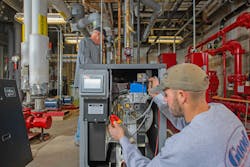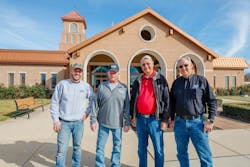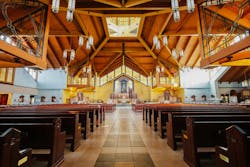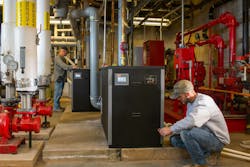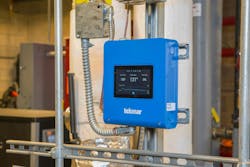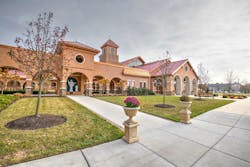Good Plumbing Performs High-Efficiency Boiler Replacement for Catholic Church
DOLYLESTOWN, PA — “Find your niche” is common advice for new business owners, sometimes followed by, “then niche-down again.”
Good Plumbing, Heating and Air Conditioning is not a new business, having served Southeast Pennsylvania for more than 75 years. Nor are they confined to a specific niche, because their 50 technicians serve a wide variety of residential and commercial customers.
That said, they’ve certainly made a name for themselves in the world of religious building hydronics—niche within a niche.
HVAC Director Don Landis, who’s been with Good for 34 years, has serviced, repaired, and retrofitted countless church hydronic systems.
The company’s boiler techs are accustomed to the challenges common to religious buildings—typically big and heavily constructed. Many are old, and more than a few have had multiple additions and floor plan changes throughout their history. Building occupancy fluctuates rapidly and dramatically, too—not unlike educational facilities.
“Our Lady of Guadalupe is the third church project we’ve done with Good this year,” said Roger Prevost, general manager and hydronic system designer at manufacturer’s rep firm ROI Marketing. “We have a long-standing relationship with them, and they do very, very nice work.”
Prevost has been focused on hydronic technology for more than 45 years and has witnessed water-based equipment and controls evolve dramatically in that time. He brought that experience with him when he and Landis navigated the unique design challenges at Our Lady of Guadalupe, in Doylestown, PA. The congregation is part of the Archdiocese of Philadelphia.
Early Failure
The 25,000-square-foot Catholic church was built in 2011. Space conditioning is supplied by five large air handlers, which were originally served by four, 399 MBH atmospheric cast iron boilers. In February of 2024, the church’s project manager, Bob Weikel, realized that two of the boilers were leaking.
“We took the damaged boilers offline and made it comfortably through heating season on 800 MBH,” said Weikel. “Redundancy was built into the original system, thankfully. I asked four different heating contractors to provide us with multiple options, ranging from simple fixes to full system replacement. We received 10 estimates in all.”
Good Plumbing, Heating and Air Conditioning was one of the companies that responded, and Landis asked Prevost to join him on the initial visit.
“The original units weren’t piped in a primary-secondary configuration,” said Prevost after walking the job with Landis. “Water flowed through all four units, similar to a reverse-return radiator system. It’s a bit interesting that two units had cracked, as opposed to one or all of them.”
Prevost and Landis realized the units may have failed due to thermal shock. Four of the five zones in the church are kept cool when mass isn’t in session, and the ventilation system brings in a lot of outside air. It’s possible that return water temperatures were low enough to damage cast iron sections, but there’s no way to be certain.
Seeking a Solution
The church’s pastor, Monsignor Joseph Gentili, has recently taken keen interest in curbing energy consumption in addition to raising the bar on facility maintenance and beautification.
One of Weikel’s latest initiatives at the church has been to improve energy efficiency. He audits the electric and gas bills and plans property upgrades accordingly. This past year, all large light fixtures in the church were upgraded to LED. The desire to lower the church’s carbon footprint played a role in selecting a boiler solution.
“Ultimately, the solution that Good and ROI Marketing provided was, we thought, the best for energy efficiency and longevity,” said Weikel. “Their plan was to install high-efficiency boilers, maintain the redundancy that saved us last winter, and provide a way for the maintenance team and myself to monitor the system remotely.”
Good’s plan was to replace all the existing boilers with two, 650 MBH Citadel condensing boilers, made by U.S. Boiler Company, while modifying the boiler room for primary-secondary piping. To provide remote system access requested by the church, a tekmar 294 Boiler Control was installed. This provides remote monitoring of individual zone temperatures and more.
The existing system pumps were serviceable and weren’t old enough to warrant replacement.
“The church effectively had a four-to-one turndown rate with the old boilers,” said Landis. “The new dual-Citadel system can modulate between 65,000 and 1.3 million BTUH. That was a big advantage considering the giant heating demand swings the facility sees. Finally, if low return water temperatures had caused the original boilers to fail, that’s of no concern with condensing boilers.”
To achieve the highest turndown possible, Prevost specified the Citadel boiler over other condensing models on his line card. Passageways through the stainless-steel, water tube heat exchanger are also larger.
“This boiler meets ASME code CSD1 out of the box because the low water cutoff is already mounted,” said Prevost. “The boiler also has a high limit control, but we add a second, external high limit control to make inspection a lot quicker.”
Two Weeks
Good’s Lead Mechanic Tom Grasse and Mechanic Wade Loughridge began tearing out the old boilers in late June.
Existing supply and return lines were cut, and new closely-spaced tees were welded in. Fittings for air elimination and sensors were also installed. No further re-piping was required.
“We weren’t pressed for space,” said Landis. “The two Citadel boilers were installed on the existing boiler pad. We offset the new units so we had 30 inches of clearance around each new boiler. That made venting a bit easier.”
Six-inch Centrotherm polypropylene was used to vent the boilers and supply combustion air through sidewall penetrations. Core drilling through the poured concrete wall was the most challenging part of the project, according to Landis.
“Combustion air had previously been supplied to the boiler room through a big fresh air duct with motorized dampers,” he explained. “We removed the dampers and locked the louvers. The Citadel boilers are approved for boiler room combustion air, but we prefer to draw from outside.”
The work was finished just before Independence Day, though Prevost joined Landis, Grasse and Loughridge onsite to program the tekmar 294 Boiler Control and start up the system in September.
“The Citadel’s onboard controls are more than capable of lead, lag and rotate operation, and using the boiler controls is super intuitive,” said Landis. “We added the tekmar control because Weikel and others involved with church maintenance wanted to monitor the system remotely.”
Fast Recovery
“We’re using the outdoor reset function on the tekmar control,” explained Prevost. “It sends a 4-20v signal to the boiler to determine firing rate based on outdoor temperature. In this area, I typically use a 14°F outdoor design temperature, but we set this system up for 20°F because churches need fast recovery. The system generates 180°F supply water at 20°F outdoor ambient. At 70°F ambient, the system provides 120°F water.”
The church maintenance team has always heated the sanctuary to comfort about one hour before the congregation arrives for mass on Saturday and Sunday.
There’s a 25°F to 40°F delta across the five large air handlers, so the heat exchangers will condense for long periods of time, maximizing energy efficiency.
Prevost estimates the church will see 40 percent natural gas savings. Not only are the new boilers more efficient with a higher turndown, but standby loss has been eliminated.
“Roger and Landis guided us along very efficiently,” said Weikel. “Their knowledge was immediately apparent and one of the biggest determining factors when we chose a contractor. We are extremely pleased with the retrofit.”
